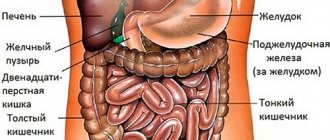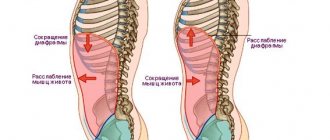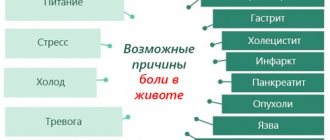Definition
The epigastric region (also called epigastrium or epigastrium) is not a separate organ, but a zone located between the umbilical part and the xiphoid process of the sternum. On the right and left, the epigastric zone is limited by the so-called midclavicular lines.
The epigastrium corresponds to the projection of the stomach, which goes to the abdominal wall, located in the front of the human body.
If pain occurs in this area, the doctor may suspect damage to the stomach, pancreas, liver, intestines, appendix and other organs. Therefore, discomfort in the epigastric region is a condition that can develop against the background of various disorders.
Structure
The epigastric region is a zone in which several organs are located. To describe the structure of this area in simple words, we can conditionally divide the abdominal region into 3 horizontal zones: hypogastric, epigastric and mesogastric.
Epigastric region
The central zone (epigastrium) can be easily determined by visually drawing a triangle on a person’s stomach. The top is located between the ribs, and the bottom of the triangle will pass along the navel line. It is this zone that is considered the epigastric region.
The epigastric region includes the stomach, duodenum, pancreas, part of the liver and gall bladder. In addition, the epigastric zone is the accumulation of the largest number of nerve endings.
This is the solar plexus, which is located closer to the top of the triangle covering the epigastric region. Due to the fact that there are a large number of organs in this part of the peritoneum, the causes of abdominal pain can also be very different.
Diseases of the epigastric region
Any disease of the epigastric region can cause pain, discomfort and other pathological sensations. The most common are:
- Gastritis;
- Gastric and duodenal ulcers;
- Complications of peptic ulcer: perforation, penetration, bleeding and others;
- Tumors of the epigastric organs;
- Pancreatitis, not necessarily affecting the body of the pancreas;
- Calculous cholecystitis;
- Enlarged liver during hepatitis, acute infections (the liver bothers the patient only in cases where it is enlarged, so hepatitis is often not accompanied by pain and discomfort in the abdomen).
Important: sometimes pain in the epigastric region may not be associated with diseases of the digestive system. For example, there are not isolated cases where myocardial infarction is accompanied by pain in the abdomen, namely in the epigastric region. This is due to the peculiarities of the innervation of the epigastrium and the reaction of the solar plexus.
In addition to myocardial infarction, pain in the epigastrium can appear due to lung diseases, namely pleurisy, lower lobe pneumonia and pneumothorax.
Types of diseases
One way or another, most of the internal organs are connected to the epigastric region.
Therefore, when pain occurs, various pathologies can be suspected:
- Stomach diseases. In this case, the person complains of severe pain in the peritoneum. Additionally, the patient may suffer from vomiting and nausea.
- Diseases of the cardiovascular system. Pain sensations are concentrated in the solar plexus area. The pain may radiate to the right shoulder and reach the jaw.
- Acute form of pancreatitis. The pain resembles colic. A feeling of discomfort may appear in the left shoulder area. The person also experiences pain on the left side of the back.
- Diseases of the intestine (large or small). The pain is localized in the upper abdominal cavity. Patients complain of attacks of nausea and vomiting. Colic may occur. Similar symptoms are most often observed with duodenal ulcers.
- Gallbladder pathologies. The pain syndrome does not allow the patient to even sleep.
- Inflammation of the appendix. The pain is localized in the umbilical region. Gradually, the pain syndrome spreads to the entire abdominal cavity and begins to intensify. The stomach hurts especially badly when walking and when lying in a horizontal position on the right side.
- Kidney diseases. Characterized by sharp pain in the central part of the abdomen. Gradually the pain shifts to the lumbar and groin area. Patients may complain of problems urinating. Bloody impurities may be observed in the urine, and a kidney stone may pass out. Renal colic may be suspected. The pathology is characterized by sharp pain under the right rib.
- Lung diseases. The pain syndrome intensifies during breathing. There is a possibility that the patient has pneumonia. In this case, in addition to pain in the epigastric region, body temperature also rises and heart rate increases. Patients experience uneven shallow breathing. There may also be problems with the diaphragm. In this case, patients experience difficulty breathing when taking a deep breath. Similar symptoms are typical for diaphragmatic hernia.
- Liver diseases. In this case, the person suffers from sharp pain of a paroxysmal nature, which is localized under the right rib.
Pain in the epigastric region
Alexei
1154 views
May 21, 2020
Hello! Periodic pain in the epigastric region, sometimes the area of pain is not entirely clear and radiates to the right and left. The nature of the pain is tolerable, there is no severe pain, it looks like a burning sensation and as if something is stabbing, sometimes it feels like something is stuck in the esophagus. There is belching after eating, sometimes heartburn (it doesn’t hurt much). Pain and discomfort do not depend on food intake, the only concern is the feeling of fullness in the stomach after eating, and as if there is a lump closer to the esophagus. There is no bitterness in the mouth or nausea. Appetite is good. I passed the following tests - blood, urine, feces, FGDS. Did an ultrasound of the abdominal cavity. Here are the results: BLOOD - ALT - 23.7 (normal 0.0-50.0); AST-18.7 (norm 0.0-50.0); alkaline phosphatase - 101 (normal 30-120); Gamma-GT - 16.5 (normal 0.0-55.0); Alpha amylase - 59.0 (normal 28.0-100.0); Lipase - 14 (normal 3 -67); Total protein - 74.7 (normal 66.0-83.0); Albumin 46.8 (normal 35.0-52.0); Total bilirubin - 24.9 (normal 5.0-21.0); Direct bilirubin - 4.3 (normal 0.0-3.4). M O C A - urine alpha amylase - 131 (normal 0-490). A N T I T E L A to Helicobacter pylori, IgG - 0.4 IU/ml. K A L general analysis - consistency - soft; Brown color; pH - neutral; stercobilin - present; bilirubin - absent; muscle fibers with striations - absent; muscle fibers without striations - single; connective tissue - absent; neutral fat - absent; fatty acids - absent; soap - a small amount; intracellular starch - absent; extracellular starch - absent; iodophilic flora - absent; digestible fiber - absent; indigestible fiber - present; mucus - absent; red blood cells - absent; leukocytes - absent; helminth eggs - not found; protozoa - not detected; yeast fungi - not detected. Ultrasound of the Abdominal cavity: LIVER. Location: typical. Contours: smooth. Sound conductivity: unchanged. Parenchyma structure: homogeneous. Parenchyma echogenicity: average. Dimensions: thickness of the right lobe 97 mm (normal up to 125 mm), CVR 119 mm (normal up to 150 mm), thickness of the left lobe 97 (normal up to 60 mm), CVR 78 mm (normal up to 100 mm) Presence of space-occupying formations and their characteristics: not identified. Vascular pattern of the parenchyma: preserved. Intrahepatic ducts: not dilated. Hepatic veins: not dilated. Portal vein: 9.5 mm (normal up to 14 mm). Inferior vena cava: 18mm (normal 25mm) Hepatic artery in the area of the porta hepatis: not dilated. GALL BLADDER. Location: typical. The presence of kinks and constrictions: in the middle third, when changing the position of the body, they are partially straightened. Dimensions: 74*19mm. Walls: 2mm (norm up to 3mm). Clearance: free. Common bile duct: 4 mm, not dilated, the lumen in the area accessible to visualization is free. PANCREAS. head 24 mm (normal 11-30mm), body 11 mm (normal 4-21), tail 20 mm (7-28). Contours: unclear. Echogenicity of the parenchyma: isoechoic of the liver. Parenchyma structure: homogeneous. Pancreatic (Wirsung) duct: not dilated. Presence of space-occupying formations and their characteristics: not identified. SPLEEN. Location: typical. Shape: typical. Contour: smooth. Structure: homogeneous. Echogenicity is not changed. Dimensions 96*36. Presence of space-occupying formations and their characteristics: not identified. Splenic vein at the level of the hilum of the spleen: not wide. Free fluid in the abdominal cavity is not detected. CONCLUSION: No organic pathologies were identified. F G D C. pH = 4.0 - against the background of bile reflux. The ESOPHAGUS is freely passable along its entire length, its walls are elastic, the mucous membrane of the abdominal segment is hyperemic, with fibrin deposits. The rosette of the cardia is elastic, does not close completely, retrograde prolapse of the gastric mucosa is determined against the background of reflux. The STOMACH is of normal shape and size, the walls are elastic, they expand freely with air. In the stomach on an empty stomach there is a lot of foamy mucous content mixed with a moderate amount of cloudy, flaky bile. The mucous membrane is normal, with areas of hyperemia. The folds of the mucous membrane are of the correct orientation, soft, mobile, and can be expanded freely with air. Peristalsis can be traced in all departments. The GOILKEEPER is of the correct shape, gapes, we pass freely for the videoscope. The duodenal bulb is normal, cone-shaped, the mucous membrane is hyperemic. HORSESHOE duodenum with normal lumen, contains bile. The mucous membrane is hyperemic, with multiple lymphangiectasia (the “semolina” phenomenon). The relief has been preserved. The BDS is not visually changed. CONCLUSION: distal catarrhal reflux - esophagitis. Indirect signs of hiatal hernia. Superficial gastritis. Duodenitis. Duodeno-gastric reflux. Indirect signs of the pancreatobiliary zone.
The question is closed
Pain in the epigastric region
Symptoms
The epigastric region is a zone of the human body where organs are located, the pathologies of which lead to discomfort in the abdominal region. In addition to pain, patients also complain of quite specific symptoms. For example, a person feels full too quickly even before the stomach is full. It doesn’t matter at all what kind of food a person eats.
If, in addition to pain and a feeling of satiety, signs of bloating appear, then the person may experience attacks of nausea and vomiting. It is worth paying attention to the appearance of a burning sensation and increased body temperature.
However, the most common symptom is pain directly in the pit of the stomach. Considering that in this zone there are a large number of organs, the diseases of which can be extremely dangerous, then if any alarming symptoms appear, it is worth visiting a doctor.
It is also worth paying attention to the nature of the pain, as this can tell you what pathology the person is suffering from.
| Symptoms | What pathologies are observed? |
| Dull or aching pain that is bothersome with equal intensity. | Gastritis |
| The so-called hunger pains that appear if a person goes to bed on an empty stomach. Symptoms may only appear at night. | Duodenal or stomach ulcer |
| Pain appears or intensifies mainly after eating. | Gastritis, stomach cancer |
| The pain is of a girdling type, and severe discomfort can radiate to the rib area and back.
| Pancreatitis |
| A dangerous syndrome in which a person may lose consciousness. Without an ambulance, there is a high probability of death. The syndrome is characterized by severe pain. The abdominal muscles become very tense, the pulse slows down, and the skin becomes pale. | Ulcer perforation |
| First there are severe abdominal pains. Then they suddenly go away, but the person’s skin turns very pale. There may be blood in the stool. Nausea and vomiting with blood are also observed. | Bleeding from an ulcer |
| The pain is localized on the right side of the ribs. The temperature rises and signs of jaundice appear. | Calculous cholecystitis |
| Malignant pathologies may not manifest themselves in any way. Some patients note weakness, a slight increase in body temperature, and sweating. Performance decreases. | Neoplasms |
It is also worth considering other features of diseases of the epigstral region.
It is important to consider at what time the pain syndrome appears and under what conditions.
For example, if the pain:
- If they last no more than 5 minutes and go away on their own, this indicates movement of the stomach muscles, or rather, they begin to tense very much.
- They last for more than 10 minutes, and there is no relationship with whether the person has eaten or not. Similar symptoms are observed in situations of panic or stress. It is not recommended to eat a lot of food in this situation. It is better to drink mint or other soothing tea.
- They appear immediately after eating and some time after food enters the esophagus. These symptoms are characterized by a decrease in sugar levels. Some people in this situation think that they are feeling hungry, but in fact the person needs to drink water.
- They are regular in nature, and discomfort mainly appears during the daytime, which can also suggest stress due to sleep disturbances. At the same time, patients complain that they cannot fully restore strength after work.
- Appear after eating fatty, hot, spicy foods. A similar reaction is observed when there are problems with the pancreas. A person suffers from heartburn and belching.
- Occurs 6-7 hours after eating. In this case, the pain syndrome gradually increases. Similar symptoms are typical for peptic ulcers and gastritis. It is necessary to conduct an examination of the stomach as soon as possible.
The epigastric region includes a variety of organs, so it is simply impossible to independently determine this or that pathology. This means that it is not enough to collect an anamnesis; you need to perform a set of tests and conduct the necessary research. Otherwise, there is a risk of serious exacerbation.
Cramping pain in the epigastrium after eating
Pain in the upper abdomen (epigastric region) is associated in patients with diseases of the stomach, however, similar localization of pain can also be associated with other organs. Pain in the epigastrium can be aching, manifested by a feeling of heaviness, can appear both on an empty stomach and after eating certain foods (spicy, irritating the mucous membrane), and can also be accompanied by nausea, vomiting or even shortness of breath.
If your stomach hurts after eating, pain in the upper abdomen is not necessarily associated with the stomach; however, pain in the stomach after eating may also appear, which is associated with the nature of the food (sharp, irritating to the mucous membrane).
In addition, pain may be associated with overeating and excessive stress on the liver and pancreas. A single large meal of fatty food can provoke pancreatitis, especially if the meal was accompanied by a libation.
Cramping pain in the epigastrium and umbilical region
Cramping pain in the epigastrium and peri-umbilical region is mainly associated with gastroduodenitis. Gastroduodenitis is an inflammatory disease of the duodenum and stomach, sometimes occurring in cases of advanced gastritis. The pain in this case is intense, located around the navel and in the epigastric region, and occurs within an hour after eating. Sometimes patients complain of heaviness in the abdomen and belching with a sour taste.
Causes of diseases
If we talk about the reasons that can provoke pain in the epigastric region, then it all depends on the specific organ. For example, if the cause of pain is lung disease, then pain in the epigastric region is explained by the fact that the epigastric zone passes directly under the lungs. Therefore, discomfort may appear with bronchitis, tuberculosis, pneumonia.
Only a doctor can help you find out exactly why discomfort and pain appeared in the epigastric region. First of all, it is necessary to visit a local therapist, who will refer the patient to the necessary specialists. Most often, people with pain in the abdominal area are referred to see a gastroenterologist. Additionally, consultation with a surgeon and cardiologist may be required.
Where is the epigastric region located?
https://youtu.be/bp884AUyrQU
The epigastric region is located between the lower thoracic outlet and the costal line. The edges of the rectus abdominis muscle divide it into three parts; they can be observed with tense abdominals.
Patients are also tormented by the question of where the epigastric region is located . The answer is simple: the epigastric zone and the epigastrium are synonyms. Another definition states that the epigastrium is the area of projection of the stomach onto the anterior abdominal wall, which is also correct.
In order to find out the location of the epigastrium, as well as the epigastric region where it is located, you can focus on some defining lines:
- ilium (passes between the anterior upper elements of the ilium);
- costal (connects the ends of twelve ribs);
- edges located outside the rectus abdominis muscle.
This area is also called the solar plexus, since this is where most of the nerve fibers are located. Due to the wide variety of pain in this area, which can radiate to other areas of the peritoneum or back, and also masquerade as diseases of other organs. Therefore, pain in the epigastrium can be varied, radiate to other areas of the abdomen and back, and imitate diseases of other internal organs.
Diagnostics
The epigastric region is a zone of the human body, pain syndromes in which may indicate pathologies of a very different nature. First of all, the therapist collects anamnesis.
It is imperative to inform your doctor about all chronic diseases in your relatives. For example, if there are people in the family with malignant tumors, then first of all the doctor will check the patient for the presence of tumors.
After this, the doctor conducts a finger examination. He palpates and alternately presses on different areas of the patient’s abdominal region. If the patient indicates pain in any place, the specialist may suggest one or another disease.
For example, if you press on the xiphoid process and the patient experiences pain, this most likely indicates cholecystitis. If the cause of pain is appendicitis, then the person experiences the greatest pain when pressing on the right iliac region.
Next, you need to donate blood and urine for tests, and conduct kidney tests. Such diagnostic measures will help to understand whether the patient is suffering from inflammatory processes.
It is also important to perform additional diagnostic measures:
- Determine the amount of pancreatic enzymes in the blood. Thanks to this study, pancreatitis can be ruled out.
- Ultrasound of the pancreas. Ultrasound examination allows you to determine exactly where the inflammation is localized.
- Ultrasound of the gallbladder. It is performed to identify stones that are necessary for the subsequent diagnosis of calculous cholecystitis. Also, an ultrasound examination will detect thickening of the walls, which is characteristic of the acalculous form of cholecystitis.
- Ultrasound of the liver. This test allows you to determine whether the organ is enlarged. Ultrasound examination can also detect cysts, helminthic infestations, inflammatory processes, bile stagnation and other pathological processes.
- Ultrasound of the abdominal cavity. Performed to detect possible tumors.
- X-ray of the abdominal cavity. The study is performed to determine whether there is an accumulation of free gas under the diaphragm dome. If it is present, then a perforated ulcer is diagnosed.
- FDGS. Used to diagnose gastritis, ulcers, tumors.
Additional research worth highlighting:
- ESR. This is a test that allows you to determine the rate and reaction of erythrocyte sedimentation. This is an inexpensive diagnostic procedure, thanks to which the presence and nature of inflammation is clarified.
- Endoscopy. Allows you to assess the condition of the stomach and esophagus. This testing also makes it possible to perform a biopsy. It allows you to confirm or deny the presence of a peptic ulcer or tumor.
- MRI and CT. Allows you to accurately determine the source of pain. Computer research is considered one of the most effective.
- ECG. This study is performed if pain in the epigastric region is not caused by gastrointestinal diseases. Similar testing is also used in diagnosing heart attacks. This study is mandatory only for patients over 45 years of age. For younger patients, ECG is recommended as a preventive measure.
If we talk about the cost of diagnostics, then the cheapest option is to go to the district clinic, where the tests will be carried out free of charge according to the health insurance policy.
However, some testing will have to wait. For example, there is usually a fairly long queue for computer examinations. If you need to complete all diagnostic tests faster, you can contact a private medical center. However, in this case, the cost of the entire set of studies may exceed 10,000 rubles.
Types of epigastric pain
It is already clear that the most common unpleasant symptom in the epigastrium is pain, but the characteristics of pain can also be different, which allows the doctor to distinguish and suspect the pathology of a particular organ. And the patient needs to know what epigastrium is in order to correctly explain his feelings to a specialist.
- Constant dull, aching pain most often indicates gastritis;
- Hunger pain - the appearance of painful sensations at night or on an empty stomach speaks of a stomach or duodenal ulcer;
- The appearance or intensification of pain after eating may be a manifestation of gastritis or stomach cancer;
- A sharp, “dagger” pain indicates a perforation of the ulcer;
- Girdle pain that radiates to the subcostal areas and back is an important manifestation of pancreatitis.
Recommendation: Attempts to self-diagnose and relieve abdominal pain are not only ineffective, but also extremely dangerous. If the pain is acute and intense, you should call an ambulance, and for dull, aching, constant pain and low intensity, plan a scheduled visit to a specialist over the next few days.
Other symptoms of abdominal pathologies
In addition to pain, diseases of the epigastric region are manifested by other symptoms, the combination of which also directs the specialist to make the correct diagnosis.
- Gastritis, stomach ulcer, duodenal ulcer. In addition to pain, these pathologies are accompanied by nausea, often in the morning.
- Perforation of the ulcer, in addition to the sudden onset of pain, leads to tension in the abdominal muscles and a slowing of the pulse. Pallor and weakness also appear, and the patient may lose consciousness. This life-threatening condition requires emergency treatment.
- Bleeding from an ulcer is accompanied by an interesting symptom - the disappearance of abdominal pain. However, instead, pallor, weakness, blood in the stool (black feces), nausea, and vomiting blood appear.
- Pancreatitis, in addition to the characteristic girdle pain, is accompanied by nausea and vomiting. Also, inflammation of the pancreas disrupts intestinal motility, so there is no rumbling in the stomach and constipation appears.
- Calculous cholecystitis is manifested by pain in the epigastrium and right hypochondrium, which intensifies with coughing. Nausea, fever, and jaundice occur.
- Neoplasms, especially malignant pathologies, may not manifest themselves for a long time. In addition, cancer has no specific manifestations, except that the symptoms of internal organ disease are accompanied by constant weakness, fever, sweating, and decreased performance.
When to see a doctor
It is important to consider that abdominal discomfort can be caused by a variety of circumstances. For example, internal bleeding could occur. Therefore, any alarming symptoms should not be ignored, especially if we are talking about acute, girdling pain.
However, even indigestion can cause unpleasant consequences, so if you feel heaviness and bloating, heartburn, or feel full too quickly while eating, you should definitely visit a doctor.
Indigestion and flatulence can be signs indicating developing gastrointestinal pathologies, infections, and inflammatory processes. Therefore, if you have pain in the epigastric region, you need to visit a gastroenterologist, oncologist, traumatologist and surgeon.
Prevention
To prevent diseases of the gastrointestinal tract and other internal organs, you need to support the immune system and monitor your weight.
You should also follow the following recommendations:
- Stick to moderate physical activity. It is equally important to keep your body in good shape. To do this, you don’t need to go to the gym, just do exercises and exercise periodically. It is better to refrain from strength exercises, as they put a lot of stress on the cardiovascular system.
- Periodically undergo general examinations and visit a therapist to assess your health.
- Treat pathologies and colds in a timely manner.
- Do not eat a lot of fried, smoked, spicy foods.
- Spend more time outdoors.
Treatment methods
When symptoms appear in the epigastric region, it is important to make the correct diagnosis. Further treatment will depend on what specific pathology caused the discomfort.
Medications
If we talk about drugs that are aimed directly at relieving a person of pain and other symptoms in the epigastrium, then most often doctors prescribe:
- Mesalazine. The drug allows you to get rid of pain due to gastrointestinal diseases. The product is sold in the form of tablets that must be taken without chewing. The dosage and duration of treatment with the drug are prescribed depending on the specific diagnosis. For example, with ulcerative colitis in the acute stage, adults are usually recommended to take 4 g of the drug per day. The reception must be divided into several stages. For children, the dosage is selected at the rate of 20 mg per 1 kg of weight. The doctor can also develop maintenance therapy. The cost of the drug is about 600 rubles.
- Prednisol. This drug is necessary to stop inflammatory processes occurring in the stomach or outside the intestines. The duration of use and dosage of the product is determined only by a doctor. The fact is that the drug can be administered intravenously or intramuscularly. There are drip and jet methods of administration. The amount of active substance depends on the stage of the pathology. The product costs about 35 rubles.
- Metronidazole. This drug has a destructive effect on microorganisms that infect the human body. The drug is also able to prevent the development of inflammatory processes in the gastrointestinal tract. For adult patients and children over 12 years of age, it is recommended to take 1.5 mg per kg of weight every 6 hours. Patients under 12 years of age should reduce the dosage and take the drug 3 times a day. However, the dosage may differ from the method of administration. For example, with the intravenous method, the initial dose should be about 15 mg per kg of patient weight. Gradually, the dosage and frequency of taking the drug is reduced. Metronidazole costs about 30 rubles.
Traditional methods
The epigastric region is an area in which inflammatory and other processes can develop. Treatment should be tailored to the specific diagnosis.
If the doctor approves of the use of traditional medicine, then there are several remedies that will help relieve pain:
- For gastritis with low acidity, it is recommended to brew watch leaves every day and drink them 4 times a day, a third of a glass.
- To prepare a general tonic, you can make a mixture of 2 parts flaxseeds and chamomile. You also need to add 1 part of licorice root and the same amount of lemon balm. After this, 1 tbsp. l. the resulting mixture must be filled with 1 tbsp. boiling water and heat on the stove for 5 minutes. The resulting product should be left for 2 hours (preferably in a thermos) and drunk 0.5 tbsp. every 3 hours. This remedy will help relieve stomach pain.
- For severe pain or stomach colic, it is recommended to make an infusion of chamomile herb. To prepare it, you need to pour 1 tbsp. l. dry mixture 1 tbsp. boiling water and leave for 20-30 minutes. This medicine should be taken 0.5 tbsp. 4-5 times a day. This infusion will help not only get rid of pain. Chamomile is also an excellent antiseptic and anti-inflammatory agent. However, if symptoms persist, you should visit a doctor.
- Blueberries have a positive effect. You can also make a medicinal infusion from it. To do this you need to pour 1 tsp. fresh berries 1 tbsp. boiling water and infuse the medicinal composition for 3 hours. After this, add a small amount of sugar or honey to the liquid and drink 50 ml 6 times a day.
- If you experience aching pain in the stomach, it is recommended to prepare a remedy based on motherwort. The juice of this plant should be drunk 1 tsp. on an empty stomach before meals.
Other methods
If pain occurs in the epigastric region, a gentle diet can also help. This is especially necessary if the patient is taking medications. The exact menu is developed by the doctor.
But, there are some general recommendations:
- Eating should be even. You can’t eat a lot at night and fast during the day.
- You need to eat food in small portions. In this case, there should be more meals. The same amount of time should pass between them.
- Don't eat too cold or hot food. The same goes for drinks, and should be consumed warm.
- It is strictly forbidden to drink alcohol or smoke.
- You need to give up fried foods. You should not consume flour products, carbonated drinks, or fast food.
What to do, what measures to take for pain in the epigastric region
Typically, drugs such as Nosh-Pa, Almagel, Gastal, Festal, etc. antacid suspensions for high acidity
If a person begins to notice heartburn, rare pain and discomfort in the stomach and digestive organs, then it is better to reconsider your diet and pay attention to the quantity and quality of foods consumed. You can go on a diet, getting rid of excessively fatty and spicy foods.
Alcohol burns the walls of the stomach, so it is harmful to health. Food that is not chewed is also harmful to health. The beginning of the digestive process occurs in the mouth, when salivary enzymes begin to slowly process food.
Constant nutrition and a complete diet can help get rid of the initial stage of problems with the digestive tract. It is necessary to eat at approximately the same time, eat little by little, and avoid carbonated drinks. And also include fermented milk products, soups and mineral water in your diet.
For healthy digestion, here are a few tips to follow:
- Eat small amounts of food, one serving should be the size of a glass. It is better to eat more often, but in small portions;
- fasting is contraindicated for people prone to gastritis. It is better to drink a glass of water or juice;
- The last meal should be 3-4 hours before bedtime. Food at night lies like a dense load in the stomach, does not allow it to rest and causes the stomach to stop working;
- Do not eat expired foods. This is how you can get poisoned;
- fast food and processed foods need to be said no! The substances added to preserve these products are very harmful;
- Heavy dishes with fat and a lot of sweets are best left until lunch. At this time, the stomach works better and burns calories for energy rather than fat;
- spend more time in the fresh air, walk in nature. This will be beneficial for the whole body, and most importantly, it will restore the nervous system and give the opportunity to work with full strength;
- It’s better not to drink alcohol, and if you have to, don’t overdo it;
- For people with gastritis, it is better to drink more water so that it washes the walls of the stomach. Water with one tablespoon of honey will also be very useful;
- In the morning after sleep, you need to drink a glass of clean water, and not coffee and tea as we are used to.
Possible complications
Any of the pathologies described in the article is dangerous due to its advanced stage. Therefore, it is important to carry out treatment in a timely manner. For example, if the patient’s condition progresses to an epigastric hernia, then tissue strangulation may occur.
Organs are at risk of ischemia and subsequent necrosis. The patient may develop peritonitis or even septic shock. These conditions are extremely dangerous and can be fatal.
Based on this, the epigastric region requires increased attention. If pain of a different nature occurs in this area, it is worth conducting a comprehensive examination. In case of timely detection of a particular pathology, the chance of restoring the normal functioning of the patient’s body increases.











